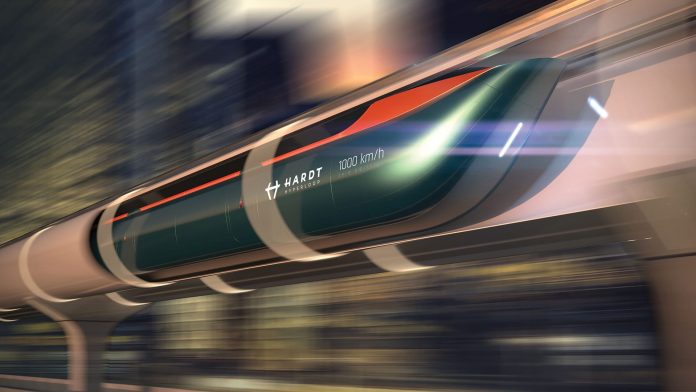EIT InnoEnergy, Europe’s sustainable energy engine, has celebrated the success of startup Hardt Hyperloop, which has successfully completed two years of feasibility tests for Europe’s first hyperloop.
The startup developed a breakthrough Hyperloop Lane Switch (HLS) technology, which allows hyperloop vehicles to change from one lane to another without additional or moving components. This enables the vehicles to retain their high speeds, effortlessly switch routes, and merge in and out of the network. The completion of the HLS marks both the end of a testing phase and the beginning of a much larger testing facility, the ‘European Hyperloop Centre’.
The first test phase assessed fundamental hyperloop technologies including magnetic levitation, low pressure environments, a propulsion system, cargo and passenger weight simulation, and lane switching technology. The next stage in hyperloop development includes a 3km track that will allow for the high speed testing of vehicles from collaborating hyperloop companies and will provide the basis for the standardisation of European hyperloop infrastructure and technology.
The completion of the first test facility was made possible by close collaboration between Hardt Hyperloop and its international partners, including Tata Steel; Dutch companies Royal Bam Group and Goudsmit; German corporations Busch and Continental; Italian Prysmian Group; and Swiss-Swedish ABB.
Hardt Hyperloop is working tirelessly to disrupt the transport industry with an innovative and sustainable mode of transport for long distance travel. Hardt and its partners are currently leading the realisation of the European Hyperloop Network – a network which will shrink the European continent with non-stop routes that cut across national borders linking near and distant European cities. Tim Houter, CEO of Hardt Hyperloop, tells us about the breakthrough technology and the future of the hyperloop.
What is Hardt’s breakthrough technology and how does it work? What are the benefits of this technology?
The hyperloop runs through a tube which has almost no air inside it, meaning there is much less air resistance and you can travel much faster for less energy and a lower price compared to the existing modes of transportation. We started up after winning the first edition of Elon Musk’s hyperloop competition, so we started a journey to make it a reality. We have shown the operations of Europe’s first hyperloop facility could work.
The hyperloop itself is completely levitated, stabilised and propelled by magnetic forces, so there is no physical contact with the infrastructure; therefore the operation expenses are extremely low, as the loop is near to maintenance free. The lane switch technology is also based on magnetic fields – without any mechanical context or moving components we can chose to go left or right just by controlling the magnetic field of the vehicle. It is very convenient to have vehicles that can switch lanes at a very high frequency. It is the combination of frictionless movement and magnetic propulsion that allows it to be very fast.
We will be introducing a large European network for the hyperloop; and we plan to connect every major European city. Local connections that take one to two hours on a normal train can take 15 to 20 minutes on a hyperloop, so those distances which are currently not commutable will become commutable: your daily urban area will therefore expand by an order of magnitude, so you can work over a much wider area. In terms of longer trips, Amsterdam to Frankfurt for example would take around 50 minutes; so these two major hubs could combine into a single vibrant community. As we build connections over longer distances, we can begin looking at competing with short haul flights; which is very interesting from an environmental point of view. Full implementation of the hyperloop network could save more than 35 million tonnes of emissions each year compared to flights over the same routes: it is a great opportunity for sustainability.
Challenges for infrastructure
We will have to work with governments and other large companies. However, this is new technology and the governments need to feel comfortable with this and know that it works, so we are taking a step by step approach to eventually show the full scale system at high speed which will be the next step after the facility. Our current test facility has the capabilities to test every critical hyperloop technology – magnetic levitation, propulsion, stabilisation – in a vacuum, on a full scale; as well as testing the lane switching technology. The goal for our next test facility is to test the high speeds. We expect it to be around 3km in length, with the facility to test at 700km/h.
With high speed trains you have large trains running on steel tracks with steel wheels, creating a lot of noise and wear; and to implement the infrastructure you need a wide area for the tracks and foundations. With the hyperloop infrastructure this can be easily implemented – you can put concrete pillars next to the existing infrastructure and put tubes on top or you can put it underground where it is not possible to implement the high speed rail. There is also no noise, and you can have three or four times the speed of high speed rail with less energy usage.
What partnerships have been formed in the making of the hyperloop and how can these benefit Europe moving forward?
It is great to see how many partners are working together on realising this facility. Throughout the process more and more partners have been added. In Europe everything is a highly collaborative effort, instead of single proprietary companies pushing everything – in our approach we are developing an open ecosystem so we can work with a lot of partners in the implementation.
For every core hyperloop technology there are already partners who can work on that, which will be a major help in the outcome of the next facility. As companies they are already positioning themselves in this hyperloop market to provide their expertise and who really support collaboration and sustainability.
How long until we see widespread implementation of hyperloop travel?
For full deployment of the hyperloop to take effect it is vital to ensure interoperability of the system and to avoid the mistake that has been made with trains, where they were running on different track widths and passengers had to transfer to another train at the borders between countries. With the hyperloop we can work towards one standardised system – this is something we are working on with other hyperloop initiatives. We will be working with the European Union and other nations on how to connect cities and how to source capital to do that – governments will have to authorise the use of land and they may wish to invest in hyperloop infrastructure, along with large institutes and private investors.
The main advantage of the hyperloop compared to trains, aside from speed and efficiency, is that it runs in a completely enclosed environment so there will be no outside effects that will harm the system. With the hyperloop we can develop a much more realisable system and delays will be a thing of the past.
From a technical point of view, development of the technology can go very fast but from an implementation point of view we also need to be realistic. So, we envision that the first group of 10-15km hyperloops could be operation in 2023, then, the extension to the first commercial routes around 2028 to 2029. It is really a team effort and we are very grateful for that.
Tim Houter
CEO
Hardt Hyperloop
+31 (0)88 024 39 20







